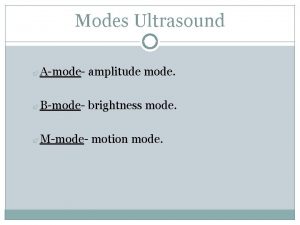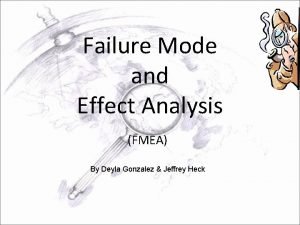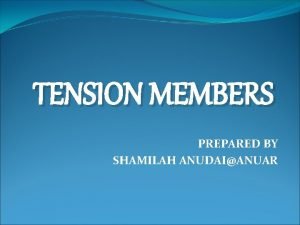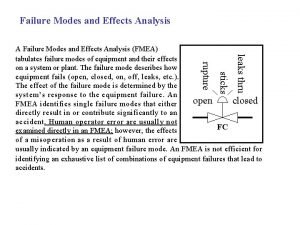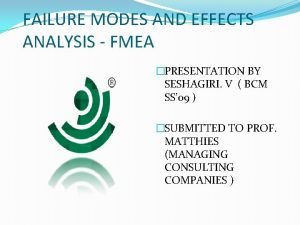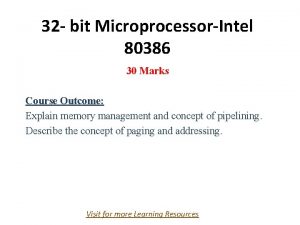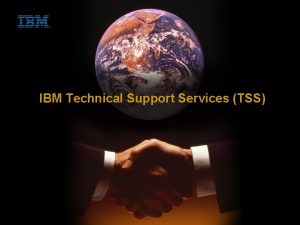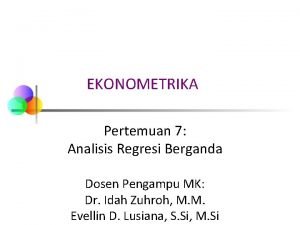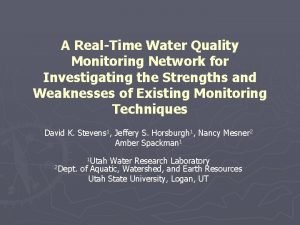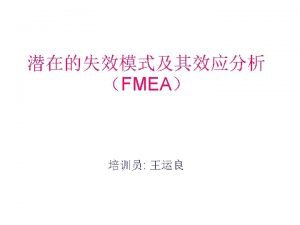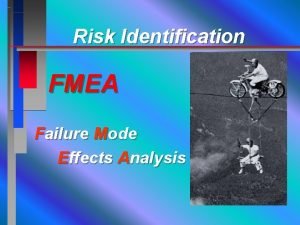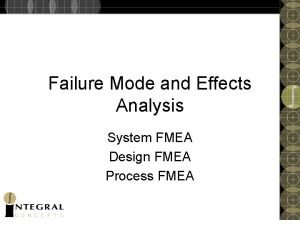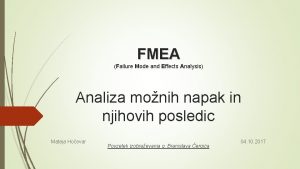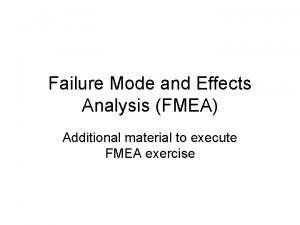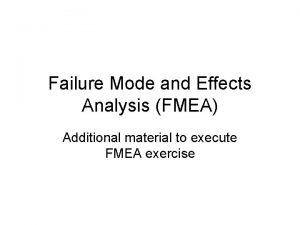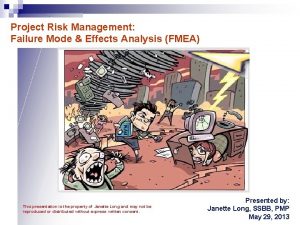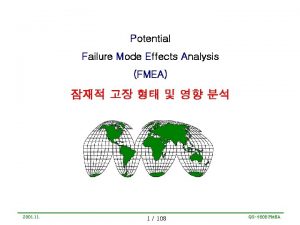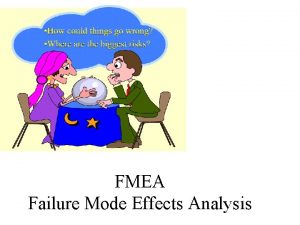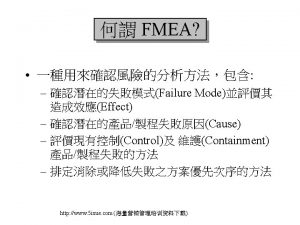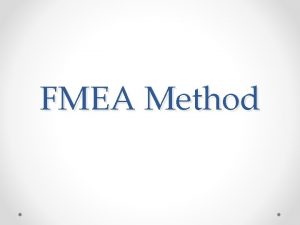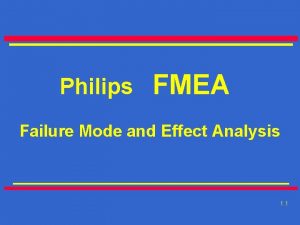TSS Failure Mode Effects Analysis FMEA ESS0275671 and














- Slides: 14

TSS Failure Mode Effects Analysis (FMEA) ESS-0275671 and ESS-0047128 - TSS CDR 2 Mikael Olsson Control Engineer www. europeanspallationsource. se

TSS FMEA - agenda 1. 2. 3. 4. 5. 6. Purpose Independent single failure criteria Fail-safe concept Failure and Failure effect Assumptions Conclusions 2

TSS FMEA - purpose • Deterministic analysis of reliabilty (SSM, D 1): – “Deterministic … methods shall be used to analyse and evaluate the … facility’s ability to fulfil the fundamental safety functions”. • Independent single failure (SSM, E 10) – “… the most adverse single failure shall be applied in the safety group. A single failure in active structures, systems, and components shall be applied at the most adverse time. ” • Independent common cause failure (SSM, E 11) – “… common cause failures in a safety group shall be applied instead of a single failure, in the same way as in Condition E 10 …” • IEC 61226 recommends FMEA to analyze Cat A systems • Independent failure in combination with external event 3

TSS FMEA - independent single failure criteria SSM conditions (C 22 ‘Intake state during failures’, guiding support doc) • “Absolute reliability of individual SSC important to safety can never be obtained” and “Failures will always be able to occur” SSM conditions (C 18 ‘Resistance to single failures’, guiding support doc) • “The key words here are ‘independent/unforeseen’, implying that the additional failure is not a direct result of the occurred event, or alternatively a failure that has not been possible to anticipate, or has been missed” IEC 61513 (single failure criterion, 3. 20, 3. 21, 3. 49, 3. 50) • • Criterion = “…must be capable of performing its safety task in the presence of any single failure” Single failure = “…loss of capability of a component to perform its intended safety function” IAEA NS-R-1 (‘Safety of NPP: design’) • • “At no point in the single failure analysis is more than one random failure assumed to occur. ” “Spurious action shall be considered as one mode of failure when applying the concept [single failure criteria] to a safety group or system. ” IEEE 379 (‘IEEE Standard Application of the Single-Failure Criterion to Nuclear Power Generating Station Safety Systems’) • • “The safety systems shall perform all required safety functions for a design basis event in the presence of the following: […] a) Any single detectable failure within the safety systems” “detectable failures = Failures that can be identified through periodic testing or that can be revealed by alarm or anomalous indication” 4

TSS architecture - fail-safe concept Each active component in the TSS has a predefined “acceptable mode for safety” in case of failure, that actuates a trip of a channel or the complete system. • Sensors – – • Hardware based train (relay) – – • Relays: predefined safe mode in case of loss of control signal. Fiber communication modules: predefined safe mode of outputs to actuators in case of loss of power or loss of communication Software based train (PLC) – • Predefined safe mode in case of loss of power Indicate trip = safe mode Predefined safe mode of outputs to actuators in case of loss of power or loss of internal communication Actuators – – Predefined safe mode in case of loss of control signal Must receive an active/continuous control signal in order to allow beam production 5

TSS FMEA - failure Sensor (pressure) Sensor reply Process status Pressure OK Pressure NOK (safe mode) Actuator Pressure NOK Performed action Most severe Close Spurious trip Close power circuit Open power circuit Most severe Open (safe mode) 2 oo 3 voting Voting result (output) Requested action Spurious trip Channel trip status (input) 0 oo 3 1 oo 3 2 oo 3 3 oo 3 No trip Trip (safe mode) 6

TSS FMEA - failure effect • Potential failure effects on the system 7

TSS FMEA - assumptions • The H 3 fire is the facility internal event that demands the TSS. – • It is assumed that other facility internal events (e. g. missiles, pipe failures, as exemplified in IEEE 384) are covered by the H 3 fire. The fire takes place in Target utility area, and leads to an accident that demands the TSS – or the H 3 fire is a consequence of such accident • The fire affects only one area (fire zone). • The fire eliminates all TSS components in the area (fire zone) – i. e. they cannot perform their safety function. • The fire does not affect the TSS sensing lines in a negative way from safety point of view. • A fire in any other area (i. e. outside Target utility area) could affect TSS components in those areas, but does not demand the TSS. 8

TSS FMEA - procedure Identify critical components Identify failures Analyze effects of independent failures - Apply independent SF/CCF Combine with H 3 fire Identify protection measure (if needed) Analyze effects after protection measure Conclude 9

TSS FMEA - details in Excel 10

TSS FMEA - conclusions (independent failure) • In general the design of the system includes both redundancy, functional separation between redundant parts, and diversity to prevent loss of function due to an independent failure. – Redundant sensors and cable paths for each safety function • Resistance to SF of the sensors – Diverse safety functions (primary and secondary function) • Resistance to CCF of the sensors – Diverse 2 oo 3 voting system (different technology) • Resistance to SF and CCF of the voting, and the associated communication equipment – Diverse actuators (different technology) • Resistance to SF and CCF of the actuators 11

TSS FMEA - conclusions (independent failure + fire) Most severe • Fire zone: Connection cell or Utility area level 115 • SF/CCF: Sensors Demanded safety function due to the fire • ‘Target rotational speed’ (connection cell) § § § • ‘He inlet temperature’ (utility area) § § • All channels eliminated Two diverse functions are needed to withstand fire + SF/CCF ‘He mass flow’ (utility area) § § § • All channels eliminated One diverse function is needed to withstand fire + SF Two diverse functions are needed to withstand fire + CCF One channel eliminated One diverse function is needed to withstand fire + SF/CCF ‘He inlet temperature’ must not be defined as the diverse function ‘He pressure’, ‘Monolith pressure’ § Same as He mass flow 12

TSS FMEA - Diverse functions (draft) • Methods of detection are identified to cover all event initiators – – He Temperature (THe) He Pressure (PHe) He Flow (FHe) Monolith Pressure (PM) Postulated Initiating Event Detection Parameter (C. 20) Helium compressor stop FHe PHe PM Heat exchanger malfunction or loss of cooling by intermediate system THe PM Helium pressure control malfunction, isolation of cooling system by valve closing PHe Power outage FHe THe PHe Large leakage – in monolith (AA 4) FHe PHe Large leakage – utility room (AA 8) FHe PHe Failure in process control system FHe THe PM Operator error FHe THe PM Leak between helium and intermediate water system (AA 7) FHe PHe Large bypass in target wheel (AA 5) Target shroud remains intact – no release 13 PM PM

TSS FMEA Thank you! 14
 Amplitude mode ultrasound
Amplitude mode ultrasound Failure mode and effect analysis
Failure mode and effect analysis Ventricular escape rhythm
Ventricular escape rhythm Failure to pace
Failure to pace Example of ductile fracture
Example of ductile fracture What is tension member
What is tension member Fmea analysis
Fmea analysis Fmea analysis
Fmea analysis Focus mode and diffuse mode
Focus mode and diffuse mode Real protected and virtual modes of 80386
Real protected and virtual modes of 80386 8088 data bus
8088 data bus Marja tetri-rantanen
Marja tetri-rantanen Tss ibm
Tss ibm Tss=ess+rss
Tss=ess+rss Tss vs turbidity
Tss vs turbidity
